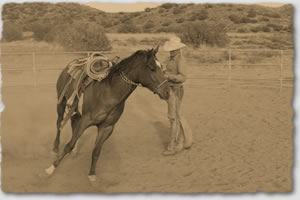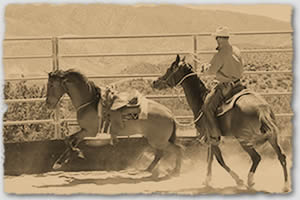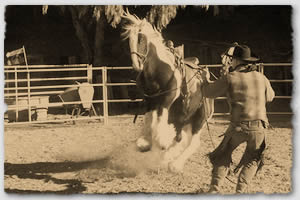

Although I work with horse at all levels I really enjoy colt starting. My colt starting program is a minimum of 90 days during which the young horse is introduced to a variety of situations that build confidence and develop skills. The goal during this crucial time is to develop a young horse’s confidence and create a strong foundation. A platform on which we can develop a solid horse for whatever disciplines we are interested in showing, pleasure ridding, or ranch work.
Watch Joel teach about colt starting. (Time: 2:37)
Because all horses are different they all learn and progress at different speeds and levels. My goals in the colt starting program are to have the horse ridden comfortably in all its gaits. Back up, side pass, drag objects, and be ridden comfortably on the trail and arena with other horses and alone. Not all horses are the same, so I attempt create a program that is in time with the horse’s learning pace. A young horse’s greatest need in my opinion is the right kind of experience. Even after a colt is started he needs your help to continue down the right path.
Starting a young horse can be a wonderful experience for a horse if done correctly. It is a great opportunity to help a horse learn and to give the horse as many new educational experiences as possible. No matter a horses breed or ultimate purpose the first 90 to 120 days will look the same. The focus of that time is to build a strong and lasting foundation to build upon regardless of the discipline it will be engaged in.
 This foundation is based on the horse’s understanding of driving and directing, which like pressure and relief is the native language of the horse. If you observe horses in a pasture they will exhibit the basic yielding to pressure. For example, a more dominate horse will move a less dominate horse the less dominate horse understands that it is to move and determines the direction by going in a direction that is open to it.
This foundation is based on the horse’s understanding of driving and directing, which like pressure and relief is the native language of the horse. If you observe horses in a pasture they will exhibit the basic yielding to pressure. For example, a more dominate horse will move a less dominate horse the less dominate horse understands that it is to move and determines the direction by going in a direction that is open to it.
Watch Joel teach about saddling the young horse. (Time: 5:26)
Ground work
Ground work is designed to teach the horse our cues using the language the horse already knows. For example, if we lead a horse to our left and encourage it forward the horse should move in the direction of our hand, in this case the left because that space is open for it to travel and is driven there by our encouragement which can be everything from a hand, hat or carrot stick. The tool used is not the focus only the concept. Not unlike using a cellphone, e-mail, landlines, etc… these tools convey our message they are not the message its self.
Groundwork is fundamental to the horses understanding of basic cues, therefore ground work is not an end in its self, rather it is a scaffold that the next scaffold will be built upon. If a horse is unable to be directed by our hand on the ground where things are simple, they will have difficulty in understanding cues from their backs when the cues are not as obvious.
A simple way to look at groundwork is as the alphabet. We use letters to make words, words to make sentences, sentences to convey ideas. If a link in the logic chain in absent or weak it will affect all that follows. Hence groundwork’s importance. However, just as it would not be enough to only learn the alphabet we must keep a horse moving forward at a reasonable and appropriate pace for that horse. Although much good has been wrought through the electronic age of 5-part DVD series, it has lent many to become box checkers. By that I mean there is a temptation to say, “we covered that,” and move forward without the horse necessarily having gained mastery of a particular maneuver.
 Thoroughness must always be balanced with understanding. The goal is for the horse to learn and like ourselves if they become frustrated they stop learning and become resentful, or worse learn the wrong thing. Thus, having a horse who is comfortable with the basics makes it both easy and productive to moving to saddling riding and achieving our goals with a willing partnership build on understanding balanced with purpose.
Thoroughness must always be balanced with understanding. The goal is for the horse to learn and like ourselves if they become frustrated they stop learning and become resentful, or worse learn the wrong thing. Thus, having a horse who is comfortable with the basics makes it both easy and productive to moving to saddling riding and achieving our goals with a willing partnership build on understanding balanced with purpose.
Depending on where a horse starts from as we look at the 30-day increments of training we have general expectations. Although we must grade on a curve meeting each horse’s unique needs, the first 30 days should have a horse being comfortably saddled, mounted ridden at the walk, trot and canter. Backing and stopping with room for improvement. Since all horse are different in their learning speeds and personalities we expect to see them functioning in this range to greater or lesser ability.
At the 60-day mark will see these skills develop and that which was a glimmer becomes more distinct and refined. We begin to introduce more collection and more complicated maneuvers such as side passing as well as the introduction of obstacles that help develop a horse’s confidence and ability to deal with things outside the classroom so to speak. At 90-120 days we should be seeing a greater amount of refinement and understanding on the horse’s part. Just as we learn different skills our continued practice and use of them make us more and more proficient, instead of thinking we have the answer we know we do. The same is true with horses being started under saddle.
Watch Joel teach about the first ride. (Time: 3:33)
